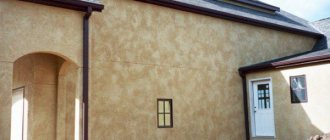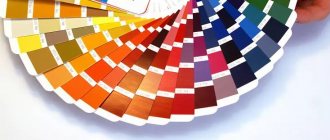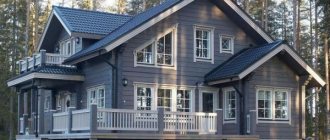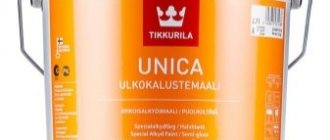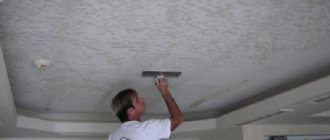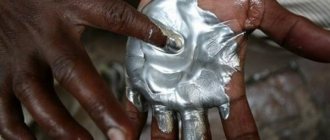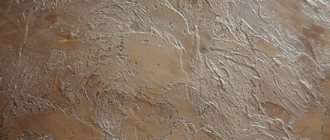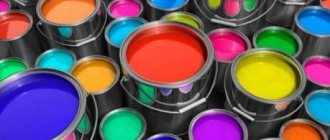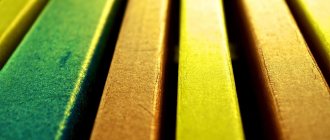Advantages and disadvantages of Tikkurila facade paint
Among the most important advantages of the exterior paint coating produced by Tikkurila are the following:
- The component composition of the mixture is characterized by a high level of environmental friendliness , since only safe substances are used in the production process. This allows the paint and varnish material to be used not only for finishing the facade, but also indoors. There are no restrictions on the use of paintwork;
- hypoallergenic . The paint has this property due to the fact that it is an environmentally friendly material. It is not capable of causing allergies, regardless of the conditions. This advantage makes it possible to use the composition even indoors in medical institutions, kindergartens or other institutions where it is especially important to use hypoallergenic materials;
- vapor permeability . This indicator of Finnish paint is at a high level. Thanks to the Tikkurila paint and varnish coating, comfortable microclimatic conditions are created in the room in which the finishing was carried out or in the entire house when finishing the facade of the building;
- ease of care. To ensure an attractive appearance of the finished surface throughout its service life, there is no need to resort to any special care measures. The surface painted with Tikkurila compounds is cleaned with ordinary water or soap solution;
- durability _ The paintwork can last a very long time;
- a long period of time in which the color of the paint does not change . The degree of saturation and brightness of the selected color for finishing will not change throughout the entire service life. The main thing that needs to be taken into account to ensure the paint has such properties is the rules for applying the material to the surface;
- The material does not suffer from terrible mechanical stress and damage . It is not afraid of the composition and exposure to all kinds of atmospheric phenomena. Wind loads and ultraviolet rays do not damage the material;
- the formation of a special protective film , which serves as an obstacle to the accumulation of dust and dirt particles on the surface of the building. This allows the coating to self-clean, which greatly facilitates the process of cleaning and maintaining the surface;
- finishing material for painting the facade is sold as a set . Paint is one of the components that is necessary for carrying out work on a wooden facade. Tikkurila produces pigments with which you can create the desired color;
- allows you to purchase a composition suitable for application to various surfaces: wood, metal, cement, lime or mineral slabs.
Regarding the shortcomings of these compositions, we can only talk about them in each specific case. For example, if any of the characteristics of the material does not satisfy the desires and needs of the owner of the house.
Interior paints Tikkurila
The Finnish company Tikkurila takes into account a variety of consumer needs, creating high-quality products for all possible occasions.
Particular attention is paid to sanitary, hygienic and environmental requirements: all interior paints are non-toxic and resistant to external influences
Another important advantage of these paints is that they can be applied to almost any surface – from fiberboard to concrete, including previously painted ones.
Tikkurila interior paints
Joker is an acrylate interior paint that meets the most stringent sanitary, environmental and hygienic standards. It is non-toxic, hypoallergenic, and wash-resistant. The optimal solution for children's rooms, canteens, cafes, and medical offices.
Harmony is an acrylate paint for interior work with exceptional aesthetic and consumer properties. Features a deep velvety matte texture. Recommended for painting walls and ceilings.
Euro (Euro) – a series of water-dispersion paints for dry and wet rooms, including ceiling and wallpaper paint. Can be used in administrative buildings and medical institutions.
Prof Euro (Prof Euro) is a series of professional water-borne paints. They form a very durable coating (matte or semi-matte), resistant to abrasion, frequent washing with detergents, steam and condensation. The paint is very economical to use and dries quickly.
Lumi is an acrylate paint for walls and ceilings with excellent covering power. Can be applied to previously painted surfaces. It has a deep white color and high covering power, tinted in light colors according to the catalog.
Luja is a super-resistant, literally indestructible acrylic paint. High humidity, mechanical stress, frequent washing with chemicals - this coating will withstand everything. It is used in rooms with high operational load and frequent wet cleaning: corridors, lobbies, hospital wards, etc.
Perfecta is characterized by very high strength and wear resistance. Gives a dense matte finish that is resistant to dirt and frequent washing. Recommended for use in children's and administrative institutions (in dry rooms).
Pesto is a series of alkyd enamels for interior work. Works well on concrete, cement, fiberboard, metal, wood. Can be used on almost any surface that is frequently washed: doors, windows and window sills, furniture, radiators, etc.
Kinds
The manufacturer Tikkurila has two types of paints intended for facade work:
- Kivisil . This type of composition is characterized by a layer that has a matte shine after application. Used as a material for finishing building facades. It contains a silicone-type emulsion, which provides a high level of protection for the surface of the house from moisture. Requires two layers of application to the surface.
- Novasil . This type of painting composition is based on acrylic. It is used for external painting of walls covered with lime-cement plaster or for mineral-fiber slabs and concrete surfaces that have not been previously painted. It is prohibited to paint surfaces that have been treated with lime-based paints or Tikkuril materials.
Tikkurila (Finland)
The Finnish concern Tikkurila is one of the recognized leaders and today its history spans more than 150 years of development. The company's products are distinguished by their diversity and consistent quality. Most of the paint and varnish compositions belong to the Premium class, which is noted at international exhibitions. Materials for coating and protecting external and internal surfaces are being developed on an ongoing basis. Particular attention is paid to the safety of the compositions; lines of compositions are produced for wooden and stone surfaces with minimal impact on the ecology of premises and the environment. The products are supplied in various volumes, each package is supplied with detailed instructions for use.
The advantages of this manufacturer's products include the following:
- There are no restrictions on the use of compositions - the environmental component of paints has been proven by numerous international tests;
- High vapor permeability - for each type of composition the manufacturer indicates its own values;
- Resistance to stains - paintwork does not require special care and can be cleaned with ordinary water;
- Resistance to ultraviolet radiation - paints do not change their color for a long time, remaining rich and bright;
- Selecting a color is necessary - the manufacturer was one of the first to offer consumers the opportunity to independently select a color using the supplied pigments.
The only drawback of the Tikkurila brand is the price.
Unfortunately, the use of innovative compositions does not reduce the cost of products, but in terms of cost/quality ratio, the concern's products clearly outperform their competitors. Characteristics of Tikkurila compositions for wooden surfaces
| Characteristics | Pika-Teho | Techo | Ultra Classic | Valtti Akvacolor |
| Application area | Acrylate waterborne paint containing oil for exterior painting of treated and untreated surfaces. | Alkyd-based oil paint is designed for high-quality protection of wooden surfaces exposed to weather conditions. | Polyacrylate paint for painting facades, cladding boards and other external wooden surfaces. Has excellent weather-resistant properties. | Water-based façade glaze based on natural oil. Used for processing external wooden structures. |
| Gloss level | Matte | Semi-gloss | Semi-matte | Not determined |
| Packaging, liter | 0,9; 2,7; 9; 18. | 0,9; 2,7; 9; 18. | 0,9; 2,7; 9; 18. | 0,9; 2,7; 9; 18. |
| Consumption | On a sawn surface – 4-6 m²/l. On planed and painted surfaces –7-9 m²/l | On a sawn surface – 6–8 m²/l. On a planed surface – 9–11 m²/l. | On a sawn surface – 4–6 m²/l. On a painted and planed surface –7–9 m²/l. | Sawn surface 4–8 m²/l, planed and log surface 8–12 m²/l. |
| Price, rub/l | 530 | 610 | 1100 | 720 |
| Cost of covering 1 m² | 60-90 rub. | 55-75 rub. | 120-180 rub. | 60-90 rub. |
Tikkurila has developed a separate line of paints for stone and concrete:
Characteristics of Tikkurila paints for stone facades
| Characteristics | Euro Façade Plus | Prof Facade | Prof Facade Aqua | Special Facade |
| Application area | Water-dispersion acrylic facade paint, modified with silicone. Protects external surfaces from mold and algae. | All-season solvent-based facade paint for painting in difficult climatic conditions. | Silicone-modified acrylic paint with high vapor permeability, suitable for finishing previously painted permanent surfaces, with the exception of those painted with lime, silicate paints and organic elastic coatings. | The paint is suitable for finishing previously painted durable surfaces, with the exception of those painted with lime, silicate paints and organic elastic coatings. |
| Gloss level | Deep matte | Deep matte | Deep matte | Deep matte |
| Packaging, liter | 2,7; 9. | 9; 18 | 9; 18 | 0,9; 2,7; 5; 9 |
| Consumption | On an absorbent surface – 4-6 m²/l, on a non-absorbent surface – 6-8 m²/l. | 7 m²/l on a flat, non-absorbent surface; 6 m²/l on uneven absorbent surface. | 6-8 m²/l on a flat, non-absorbent surface; 4-6 m/l on an uneven absorbent surface. | 6-8 m²/l on a flat, non-absorbent surface; 4-6 m²/l on uneven absorbent surface. |
| Price, rub/l | 330 | 450 | 320 | 320 |
| Cost of covering 1 m² | 40-55 rub. | 65-75 rub. | 40-50 rub. | 40-50 rub. |
In this video you can see an example of painting a wooden facade with Tikkurila paint:
Characteristics
Regarding the characteristics of Tikkurila paint and varnish material, we can say the following:
- The material is able to withstand, after application and drying, a temperature of 400 degrees Celsius . This characteristic allows the paint to be used in all kinds of extreme load conditions;
- paint consumption is from 150 to 200 ml per 1 square meter . For application it is possible to use brushes, rollers or sprayers;
- It is recommended that work be carried out using Tikkuril paints and varnishes in conditions of positive temperatures and humidity not exceeding 70%;
- The paint layer after drying provides reliable protection against moisture absorption, combined with a high level of vapor permeability . Walls coated with Tikkurila paint breathe freely.
IMPORTANT!
The main component of the paint is silicone resin , thanks to which a high level of all technical characteristics is achieved.
Style and design
Before starting renovations, every person in the street wants to create a unique and stylish design in their apartment. Using tikkurila paint, you have endless possibilities in creating a stylish interior. You can experiment with the choice:
- Color range of shades;
- Gloss levels;
- The structure of the material.
Additionally, it is possible to create drawings and special effects. If the design you created is outdated or tired, you can easily update it. Interesting design solutions and the latest ideas from the Tikkurila company will help you. They offer ideas on how to paint:
- The hallway, for example: by giving the ceiling an original and bold color, it will shine with newness.
- Living room - painting it in light colors with the addition of a black fragment.
- Bedroom in monochrome tone.
- Paint the nursery like a real jungle.
- Kitchen in retro style.
- Cabinet in a perky one-off color.
- Furniture: bright children's bed.
- Country house - paint with dark wood paint.
- Wallpaper.
Wallpaper for painting
Paintable wallpaper will help you create a stylish design. They differ in material and texture. Difference in materials:
- Glass wallpaper - moisture-resistant, durable, fire-resistant;
- Non-woven – with a finished pattern;
- Vinyl.
Surface preparation
The preliminary stage before painting the house is to prepare them for further work.
It is carried out as follows:
- The first step is to level the surface of the walls . They should not have visible bumps, various dents or any other defects. Often a primer is used to achieve a good result.
- If any section of the wall is damaged by mold or fungus has formed on it, then it must be cleaned using a stiff brush and treated with a special composition that has antiseptic properties. Then, if necessary, level the surface.
- The last step in preparing the walls is to clean them of dirt and dust particles. To carry out this activity, it is better to use a soap solution or plain water. After thoroughly washing the entire surface of the walls, you need to give them time to dry completely.
- After the preparatory stage, the surface is thoroughly primed.
CAREFULLY!
You cannot start painting the facade without waiting for the walls to completely dry after the preparatory work . Also, painting should not be carried out in weather conditions with high humidity.
Decorative effect paints
A room painted in a single color looks clean, but boring. If you paint the walls using paint with a decorative effect, the room will take on an exclusive look. Paint in this category is called decorative. Using decorative paints the following effects are created:
- Under the cut of natural stone;
- Under the skin;
- Velvety surface;
- With the effect of silk thread;
- Nacre;
- With a metallic sheen.
The paint is applied to the surface using conventional tools, a brush, a roller or a spray gun. To achieve a more pronounced effect, use rollers with a highlighted relief or a special pattern. Calculate the material consumption for at least two layers. Popular varieties of decorative paint from Tikkuril:
- Harmony - requires ideal preparation of the walls, they must be smooth.
- Liitu - for school boards.
- Magnetic – with magnetic properties.
- Miranol – for metal and wood surfaces.
- Thai - for wooden, concrete, chipboard and plasterboard surfaces.
Don’t be afraid to experiment; any paint applied will create a unique and interesting result.
Tinting
The paint produced by Tikkurila requires tinting . To do this, you can use a special color design program, thanks to which you can easily identify the desired combination of paste pigments. Such pastes are added to the base paint.
Tinting can be done with almost any composition. Through the use of tinting pastes, it is possible to obtain 15,000 different shades , which, if necessary, can be reproduced exactly.
For tinting paints intended for facade work, pastes with markings are used:
- VT;
- MK;
- ZK.
You can transport tinting using special equipment, or with your own hands. To independently obtain the required tone and color of the composition, you can use the following recommendations:
- First, prepare several plastic containers;
- then pour 100 ml of base paint into one of the containers;
- after this, they begin to gradually add pigment drop by drop . If it is necessary to obtain a rather complex color, then it is necessary to use a combination of several pigments;
- in the process of creating color, you should definitely record both the exact amount of base paint that is used in the process and the amount of pigment paste;
NOTE!
For each such combination, it is necessary to indicate the result that is obtained after mixing.
- after each addition of pigmented paste, it is necessary to thoroughly stir the entire composition;
- it is necessary to add color until the desired result is achieved;
- After the required color is obtained in the volume taken for testing, you can begin to create it in the main container of the paint and varnish composition. First you need to calculate the required amount of pigment.
color effect
Tikkuril paint colors have their own unique composition. The large selection of colors is due to the fact that each person has his own taste, and everyone likes a certain color (and sometimes its shades).
Let's take the matte option, for example. Paint of this type in most cases has classic, calm and muted tones. The glossy version, on the contrary, can use the entire palette of shades that can be found in special fans.
When choosing paint and varnish products, it should be taken into account that the matte version is more intended to hide some roughness and errors on the wall, but gloss, on the contrary, will show all the disadvantages in all its glory. Therefore, before applying glossy paint, it is necessary to clean the surface to perfect condition (as far as possible).
It is this process that allows you to find exactly what your soul likes most. And then ordinary orange, yellow and other colors turn into an amazing golden or silver hue.
Painting process
Having selected suitable climatic conditions for finishing work using Tikkurila paint and varnish composition, you can begin the process of painting the building. Painting can be done with a brush or roller . For those who have experience working with a spray gun, there is an opportunity to use it.
The painting process is divided into several stages:
- Having chosen a suitable tool for painting, a certain amount of the prepared composition is poured into a special container;
- then, having dipped the tool into the coloring composition, they begin to apply it to the surface of the wall of the house;
- It’s better to start the process from the top. Gradually, avoiding smudges and unpainted areas, paint is applied to the entire surface of the facade of the house;
- It is best to stick to the minimum possible layer of paint when applying the composition. This will ensure uniform drying and good adhesion to the base wall material;
- After the paint has been applied to the entire facade, it is necessary to leave the work for the time necessary for the surface to dry completely . The approximate amount of time required for this can be found by reading the Tikkuril paint instructions;
- after the specified period, begin staining again . In this case, it is best to distribute the composition randomly - this will allow you to achieve the most uniform layer.
How to paint with Tikkurila
To obtain a high-quality result, the company recommends choosing paint that matches the type of wall. It is also useful to determine the paint consumption in advance (by the area of the facade) and plan the work for a favorable, dry and warm period.
Surface preparation
The surface of the facade is prepared in accordance with the requirements of the technical specification for the selected paint. The first step is leveling the surface. To avoid problems with painting, the facade is cleaned of dust and dirt (water or soap solution will do). After complete drying, the facade is primed; this helps get rid of defects - small irregularities, scratches and damage. Areas with mold are given special attention. Such fragments are cleaned with a stiff brush and treated with an antiseptic, and after drying they are also leveled with a primer.
Tinting
To paint the facade, you can use ready-made paints from the main color palette. But often a special, rare shade is needed. It is selected from the company’s catalog, which contains thousands of shades, and is obtained by tinting.
Tinting, the process of obtaining paint of the chosen shade, is most conveniently carried out in a store, using Tikkurila tinting equipment. The program calculates the proportions of the main paint and additional pigment (one or a combination of several). The paints are mixed until completely homogeneous, and the customer receives exactly the desired shade.
The tinting operation can be carried out manually, for which the desired color is first obtained on a sample of the base paint, gradually adding pigments to it and fixing the proportions. If the color that needs to be obtained includes a combination of several pigments, manual mixing cannot always obtain the desired shade and then accurately reproduce it.
Painting process
Painting should be carried out in accordance with the instructions placed on the paint can; painting includes the following steps:
- Selecting a tool. This could be a brush or roller. If there is a large amount of work to be done, it is beneficial to use a spray gun. Don't forget about safety glasses and gloves.
- The paint is applied using the methods specified in the specification. Before starting work, part of the composition is poured into a smaller container; this will help keep the rest of the paint from drying out.
- Painting is carried out carefully and carefully. Each wall is painted without long breaks; otherwise streaks will appear on the surface.
- The paint is spread in a thin layer. In this case, the brush or roller is moved with vertical, horizontal and diagonal movements alternately.
- Re-painting is carried out after the first layer has completely dried.
- During breaks, the tools are wrapped in plastic so that the paint does not dry out.
The determining conditions for long-term and flawless service of the facade are careful preparation of the surface and the choice of appropriate paint. The Tikkurila company offers products for each stage of repair work - not only a variety of protective and decorative coatings, but also preparations for painting and priming of facade walls, which improve the adhesion of the finishing layer.
Belinka (Slovenia)
The Belinka company rightfully occupies one of the leading places among manufacturers and developers of paint and varnish coatings. Traditional and innovative paint compositions make it possible to carry out preparatory and finishing work on decorating surfaces made of various materials. As a rule, all basic coating ingredients have undergone repeated testing in laboratories and in practice, so consumers fully trust the company’s reputation. Product safety has been elevated to the rank of mandatory properties of manufactured paints; compositions are tested both by our own specialists and by independent experts.
The advantages of Belinka products are:
- Ready-made complexes of impregnations and protective coatings with clear instructions for the use of the compositions;
- Possibility of tinting paint in various colors using a basic white composition;
- The color of the finished paint is practically unchanged from batch to batch; automated lines with component dosing are used in production.
The disadvantages of Belinka's compositions include strict requirements for surface preparation.
Violation of the technology can lead to paint peeling and peeling of the surface layer, which entails additional costs for re-application of the protective coating. But even here you can find advantages that are expressed in simple correction of errors - the paint does not need to be completely cleaned, it is enough to remove the damaged layer using a simple abrasive. Characteristics of Belinka acrylic paint
| Characteristics | IN 1 | AT 2 | AT 2 |
| Application area | Belinka acrylic paint is intended for the protection and decoration of facades and any other external mineral surfaces. | Designed for the protection and decoration of facades and any other external mineral surfaces. Features good adhesion to most substrates, good resistance to climatic influences and harmful industrial environments | Serves to protect and decorate facades and any other external mineral surfaces; the paint is resistant to wet abrasion. Suitable for repair painting of old dispersion coatings. |
| Color | White with the possibility of tinting in soft pastel colors | Translucent composition, tinted in rich tones | Translucent composition, tinted in rich tones. |
| Packaging, liter | 2; 10 | 1,86; 9,3 | 1,86; 9,3 |
| Consumption | 3-4 m²/l | 3-4 m²/l | 3-4 m²/l |
| Price, rub/l | 400-600 depending on the quantity in the package | 355-460 | 310-400 |
| Cost of covering 1 m² | 100-150 rub. | 88-115 rub. | 80-100 rub. |
Characteristics of Belinka silicone paint
| Characteristics | IN 1 | AT 2 | AT 2 |
| Application area | Vapor-permeable and weather-resistant paint designed for professional high-quality protection and decorative design of facades. | It is used for painting all types of mineral and dispersion plasters, fiber-cement and wood-cement boards, as well as for restorative painting of old dispersion coatings. | It has good adhesion to most substrates, elasticity, high water repellency and vapor permeability, contains a biocide additive that protects the coating and prevents the development of microorganisms on the surface. |
| Color | White composition, tinted in pastel colors. | Translucent composition, tinted in rich tones. | Translucent composition, tinted in rich tones. |
| Packaging, liter | 2; 10 | 1,86; 9,3 | 1,86; 9,3 |
| Consumption | 4-5 m²/l | 4-5 m²/l | 4-5 m²/l |
| Price, rub/l | 488-565 | 500-580 | 472-560 |
| Cost of covering 1 m² | 98-113 rub. | 100-117 rub. | 94-111 rub. |
The variety of compositions from the Belinka company makes it possible to paint almost any surface, and the master class on the presented view will convince you of this:
